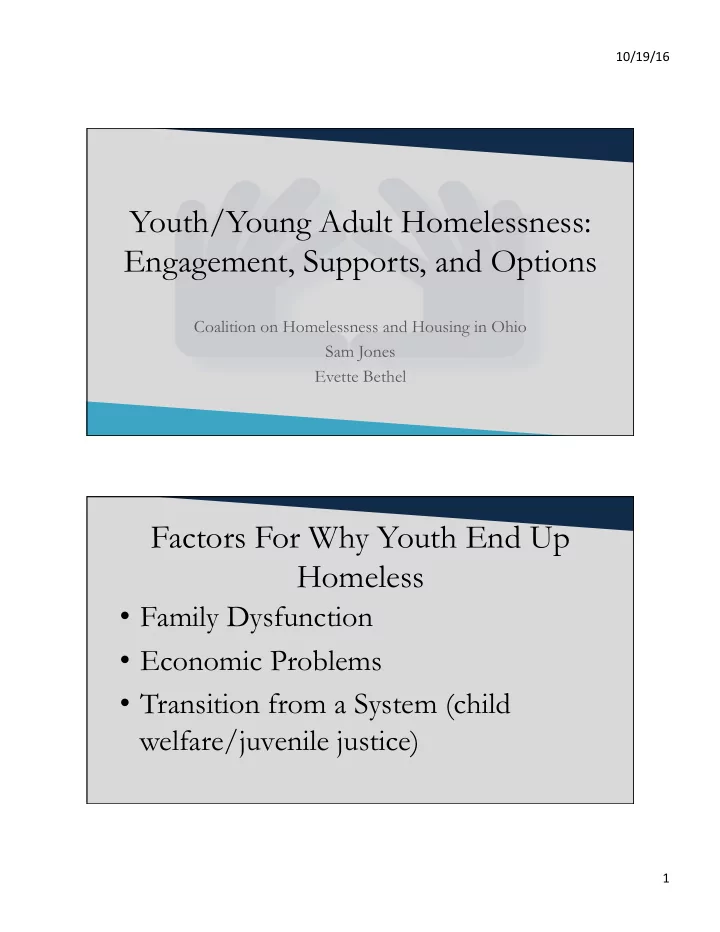

10/19/16 ¡ Youth/Young Adult Homelessness: Engagement, Supports, and Options Coalition on Homelessness and Housing in Ohio Sam Jones Evette Bethel Factors For Why Youth End Up Homeless • Family Dysfunction • Economic Problems • Transition from a System (child welfare/juvenile justice) 1 ¡
10/19/16 ¡ Trauma vs. Homeless Youth… Experienced and survived trauma Most Vulnerable and Overly Represented 2 ¡
10/19/16 ¡ Specific Populations Once Homeless… • Runaway and homeless youth experience rape and assault rates 2 to 3 times higher than the general population of youth (Robertson & Toro, 1998) • More than one third of homeless youth engage in survival sex (Ray, 2004) 3 ¡
10/19/16 ¡ Non-Service Connected Youth • Less than 10% of homeless youth access community resources meant to serve them (Kelly & Caputo, 2007) • Only 20-30% of homeless youth report ever having stayed at a crisis shelter, 9% report having ever accessed mental health services, and 15% report ever having received substance abuse treatment (Ray, 2006; Springfield’s Housing Collaborative, 2007) Transition • Transition to independence is an extremely vulnerable period. • Increased supports and interventions are crucial. 4 ¡
10/19/16 ¡ Identifying and Engaging Youth • Language • Careful not to ‘out’ homelessness • Authenticity and trust • Meet youth where they want to be met Models / Evidence-Based Practices • Trauma-Informed Care (TIC) • Positive Youth Development (PYD) 5 ¡
10/19/16 ¡ What is Trauma? Individual trauma results from an event, series of events, or set of circumstances that is experienced by an individual as physically or emotionally harmful or life threatening and that has lasting adverse effects on the individual’s functioning and mental, physical, social, emotional, or spiritual well-being. From “What’s Wrong?” To, “What’s Happened?” • What is your story? How • What is your did you end up here? diagnosis? • How have you coped VS. • What are your and adapted? symptoms? • How can we work • How can I best help together to figure out or treat you? what helps? 6 ¡
10/19/16 ¡ • All behavior has meaning • Symptoms are ADAPTATIONS • We build on success not deficits Almazar Consulting Problems or Adaptations? • Fight – Non-compliant or combative OR struggling to hold on to some personal control/power? • Flight – Treatment resistant, uncooperative OR disengaging, withdrawing or titrating external stimulus/demands • Freeze – Passive, unmotivated OR giving in to those in power, repeating cycle of surrender in order not to get hurt 7 ¡
10/19/16 ¡ Power of Empathy • Dr. Brene – Video https://www.youtube.com/watch? v=jz1g1SpD9Zo Positive Youth Development (PYD) • Youth Centric • Choices • Options • Solutions 8 ¡
10/19/16 ¡ It Takes A Community! Continuum of Care (CoC) • CoC, a geographically based group of representatives that carry out the planning responsibilities of the HUD’s Homeless Assistance Program. • The Continuum of Care Program is designed to promote communitywide commitment to the goal of ending homelessness • Coordinate local homeless systems & programs Supports • Kin or family – Keep in mind family can be non-traditional • Community • Mentors • Youth friendly spaces Think outside of the box! 9 ¡
10/19/16 ¡ Tangibles Intangibles Clothing Feeling of safety Sense of Food belonging Identification Peer support Permanent Transportation connections Supplies Choice Place to shower Voice Equal involvement Clean laundry in activities A Cross-Systems Approach • Collaboration • Coordinated effort • Linking housing and services 10 ¡
10/19/16 ¡ Thank You! Sam Jones Youth Initiative Specialist samjones@cohhio.org Evette Bethel Youth Initiative Coordinator evettebethel@cohhio.org 11 ¡
Recommend
More recommend